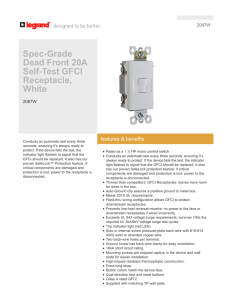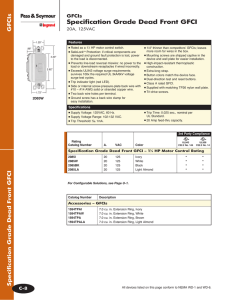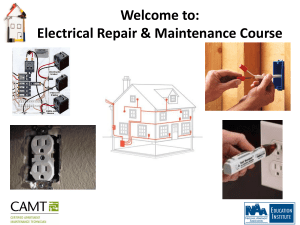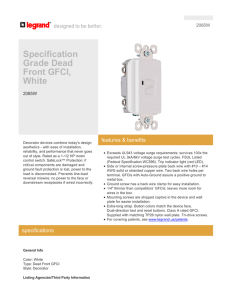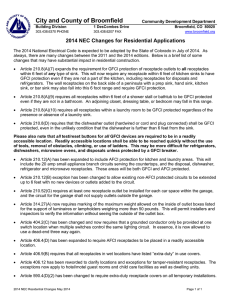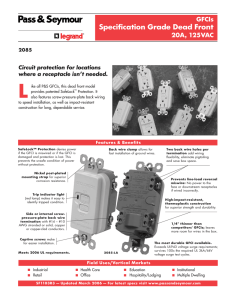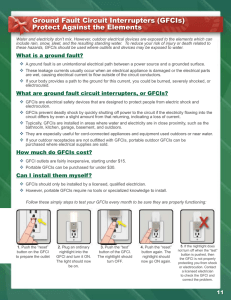Underwriters Laboratories Inc.
advertisement
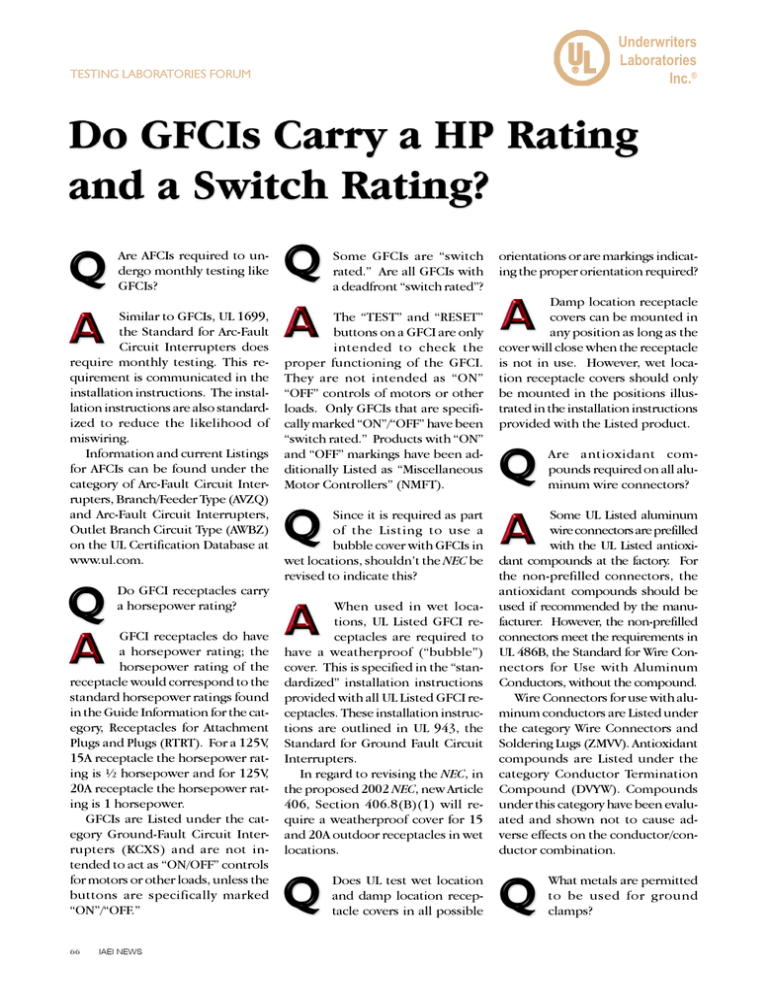
Underwriters Laboratories Inc.® TESTING LABORATORIES FORUM Are AFCIs required to undergo monthly testing like GFCIs? Some GFCIs are “switch rated.” Are all GFCIs with a deadfront “switch rated”? Similar to GFCIs, UL 1699, the Standard for Arc-Fault Circuit Interrupters does require monthly testing. This requirement is communicated in the installation instructions. The installation instructions are also standardized to reduce the likelihood of miswiring. Information and current Listings for AFCIs can be found under the category of Arc-Fault Circuit Interrupters, Branch/Feeder Type (AVZQ) and Arc-Fault Circuit Interrupters, Outlet Branch Circuit Type (AWBZ) on the UL Certification Database at www.ul.com. The “TEST” and “RESET” buttons on a GFCI are only intended to check the proper functioning of the GFCI. They are not intended as “ON” “OFF” controls of motors or other loads. Only GFCIs that are specifically marked “ON”/“OFF” have been “switch rated.” Products with “ON” and “OFF” markings have been additionally Listed as “Miscellaneous Motor Controllers” (NMFT). Do GFCI receptacles carry a horsepower rating? GFCI receptacles do have a horsepower rating; the horsepower rating of the receptacle would correspond to the standard horsepower ratings found in the Guide Information for the category, Receptacles for Attachment Plugs and Plugs (RTRT). For a 125V, 15A receptacle the horsepower rating is ½ horsepower and for 125V, 20A receptacle the horsepower rating is 1 horsepower. GFCIs are Listed under the category Ground-Fault Circuit Interrupters (KCXS) and are not intended to act as “ON/OFF” controls for motors or other loads, unless the buttons are specifically marked “ON”/“OFF.” 66 IAEI NEWS Since it is required as part of the Listing to use a bubble cover with GFCIs in wet locations, shouldn’t the NEC be revised to indicate this? orientations or are markings indicating the proper orientation required? Damp location receptacle covers can be mounted in any position as long as the cover will close when the receptacle is not in use. However, wet location receptacle covers should only be mounted in the positions illustrated in the installation instructions provided with the Listed product. Are antioxidant compounds required on all aluminum wire connectors? When used in wet locations, UL Listed GFCI receptacles are required to have a weatherproof (“bubble”) cover. This is specified in the “standardized” installation instructions provided with all UL Listed GFCI receptacles. These installation instructions are outlined in UL 943, the Standard for Ground Fault Circuit Interrupters. In regard to revising the NEC, in the proposed 2002 NEC, new Article 406, Section 406.8(B)(1) will require a weatherproof cover for 15 and 20A outdoor receptacles in wet locations. Some UL Listed aluminum wire connectors are prefilled with the UL Listed antioxidant compounds at the factory. For the non-prefilled connectors, the antioxidant compounds should be used if recommended by the manufacturer. However, the non-prefilled connectors meet the requirements in UL 486B, the Standard for Wire Connectors for Use with Aluminum Conductors, without the compound. Wire Connectors for use with aluminum conductors are Listed under the category Wire Connectors and Soldering Lugs (ZMVV). Antioxidant compounds are Listed under the category Conductor Termination Compound (DVYW). Compounds under this category have been evaluated and shown not to cause adverse effects on the conductor/conductor combination. Does UL test wet location and damp location receptacle covers in all possible What metals are permitted to be used for ground clamps? Underwriters Laboratories Inc.® Ground Clamps are Listed under the category Grounding and Bonding Equipment (KDER). A grounding or bonding device is required to be constructed of a metal or metals that, when the device is installed under conditions of actual service and exposed to moisture, it is not likely to be adversely affected by electrolysis. A grounding or bonding device marked as acceptable for burial in earth or embedment in concrete is required to be constructed of copper or a copper alloy contain- TESTING LABORATORIES FORUM ing not less than 80 percent copper, or stainless steel. The Standard for Grounding and Bonding Equipment, UL 467, does allow for other materials for a device intended for burial in earth or embedment in concrete if it has been investigated and found to be acceptable for the application. Among the factors that are taken into consideration when judging the acceptability of such a material are the change of resistance across the bonding-grounding joint, and the amount and degree of corrosion. Aluminum or aluminum compound is not permitted for “direct burial” applications. The special UL meetings for government inspectors provide us an excellent opportunity to ask questions of UL engineers and to clarify UL requirements. The “UL Question Corner” answers questions of general interest that are sent in from authorized governmental inspectors and we believe will have interest for many inspectors. Please send us questions you may have that are of general interest, and we will have UL engineers answer them in a future issue. If space does not permit answering all questions received, we’ll see that you get an answer by letter. Send your questions to: UL Question Corner - IAEI News PO Box 830848 Richardson, TX 75083-0848 SEPTEMBER/OCTOBER 2001 67
